|
Zulu Nyala, South Africa
Zulu Nyala, South Africa - Day 3
Friday Morning, September 8
The morning's expedition is walking through an area inaccessible to vehicles, a known home to hippos, the suspected recent elephant hiding area, and the occasional hunting area of the local leopard.
First thing in the morning, we spotted these helmeted guinea fowl.
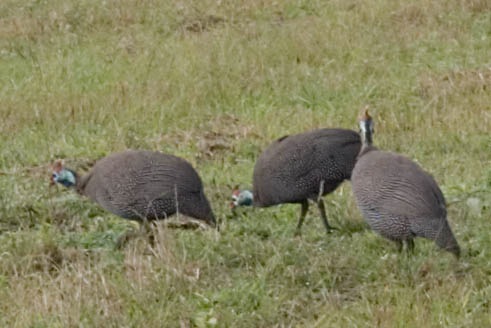
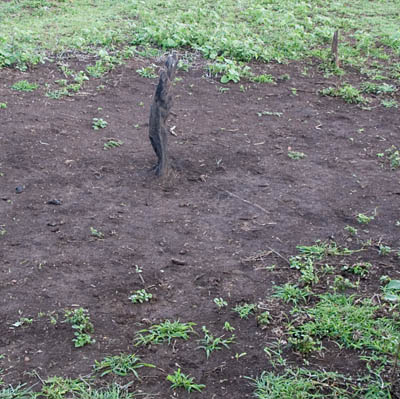
It's a scratching post made from the remnants of a tree trunk broken by an elephant. Hippos and rhinos cover themselves with mud. Parasites on their hides get trapped in the mud. After the mud has dried, they roll around against the scratching post and remove the mud along with the parasites. Other animals use it as well.
Kudu are a third species of the deer/antelope variety. They are the most skittish of the three, not nearly as calm around the vehicles as the impala and nyala. We had seen glimpses of them before, but we finally got a decent photo of one, an adult female. As you can see they have the same vertical white markings as the nyala, but have a shoulder hump, a different body color, and are noticeably larger.
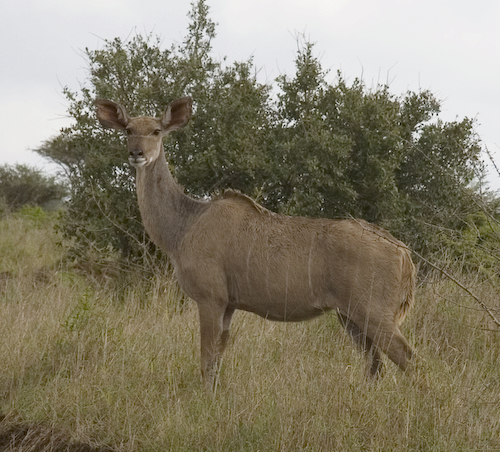
On the way there, we also saw a half dozen giraffes. We got out of the vehicle for a closer look. They are more comfortable with the vehicle than with people on foot, and kept a bit more distance between us and them, but still hung around and let us take photos. In fact, they seemed as curious about us as we were about them.
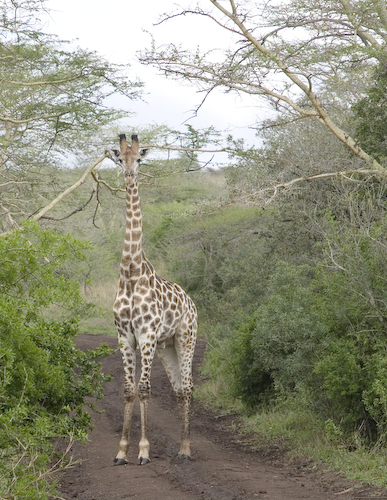
Since we don't have the protection of the vehicle, Marius is required to carry a rifle and gives us a new set of safety procedures to make our group look intimidating and not like an opportunity to pick off the slowest and weakest member of the herd. Mostly, it's stay clumped together and don't get between the rifle and any potentially dangerous animal.
Can you tell what's interesting in this photo?
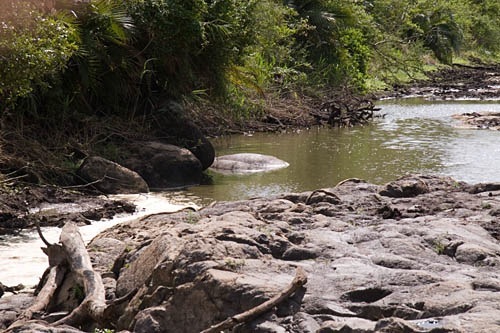
For one thing, this pond used to be part of a year-round river. The Zulu Nyala area has been experiencing an unprecedented drought for four years. What's left of the river is a few scattered ponds. Elsewhere we saw a dry river bed where they used to run boat tours just a few years ago. We were constantly faced with the impact global warming is going to have on these animals and the people who live in this area.
Of more immediate interest, the two rocks by themselves in the center of the photo are actually hippos. More people are killed in Africa by hippos than any other animal. You don't want to surprise a hippo, or be surprised by an angry hippo, so it's good to have a guide that knows his stuff.
Here's a clearer photo of the same hippos.
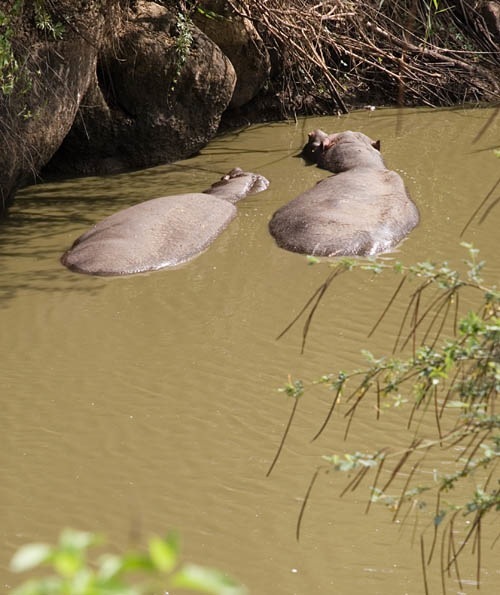
This is the group, all but Jim (Barbara's husband) and Tom (Cathy's companion).
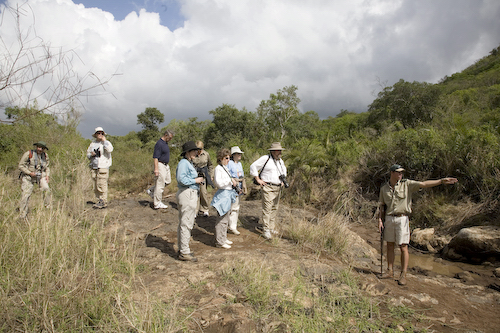
From left-to-right, it's Lee, his wife Sam, Bob, Barbara, Cindy, Cathy, Lauren, Glen and Marius.
We did find signs of recent elephant occupation by the bucket-load. This particular pile gave Marius a good opportunity to point out a dung beetle and explain their life cycle.
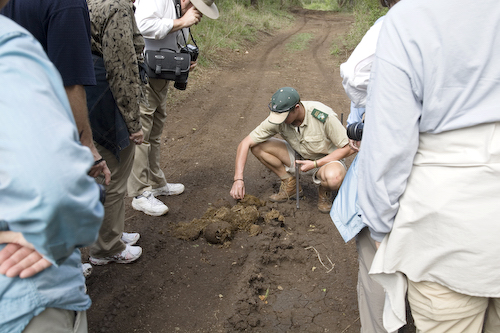
Young beetles find a good deposit, camp out there eating until they're big enough to mate. A male will start rolling a ball of dung until it's large enough to hold and feed a nest of eggs. When his fortune is large enough to properly impress a female, they mate and she deposits her fertilized eggs into the ball. The male then rolls it to a good spot and either hides it or buries it. To move it, his grips it with his back legs, then pushes against the ground with his front legs.
Later Marius found a beetle pushing his future progeny and their inheritance across the road. We were all so excited, we jumped out of the truck and photographed the event.
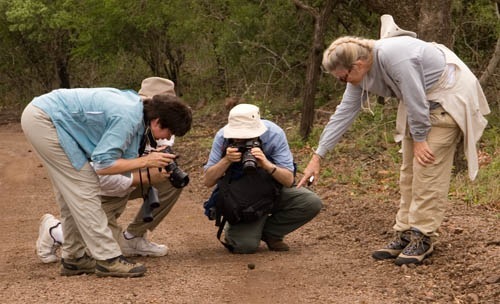
Here's the little guy looking for the best spot to park his home.
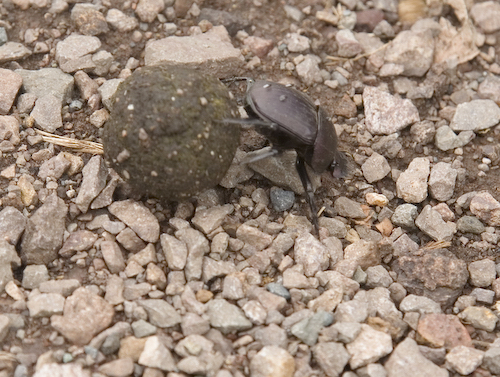
Of course, the view isn't always as good as a ball of dung being rolled across the road, sometimes we have to settle for a bit of scenery like this...
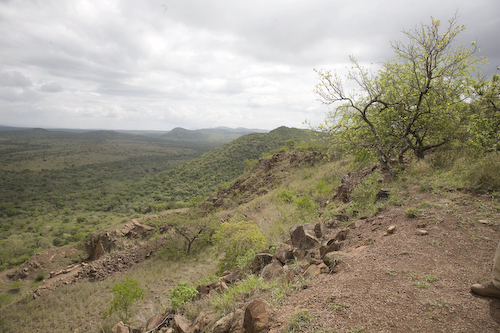
This is our land rover.
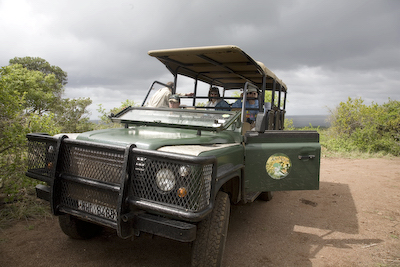
On the way back to the hotel, this nasty little thing flew into Tom's collar and stung him three times.
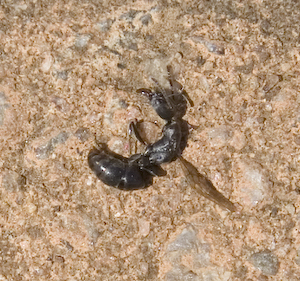
We decided that since it wasn't a mosquito or a tsetse fly, if it killed him it would at least be more interesting than malaria or sleeping sickness. He described it has feeling like he'd been brushed with a nettle. Cathy pounced on him with Benedryl cream, which clearly it up quickly and completely. There's a travel tip for you.
Friday Afternoon, September 8
Instead of a ride through the preserve, Marius arranged for us to go to a rescue and rehab center for cheetahs and other cats at Emdoneni Lodge. The center cares for rare and endangered cats that have been injured or captured, or when people who tried to keep them as pets realize that doesn't work.
The curator, Amanda, took us on a tour of the cats, starting with the servals. As she approached the cage, they knew it was dinner time and responding with loud moaning sounds. Amanda threw them some raw meet to occupy their interest, then she let us all in to their pen to see and photograph them up close. Not a lot bigger than a house cat, they still looked mean enough you wouldn't want to wrestle with them.
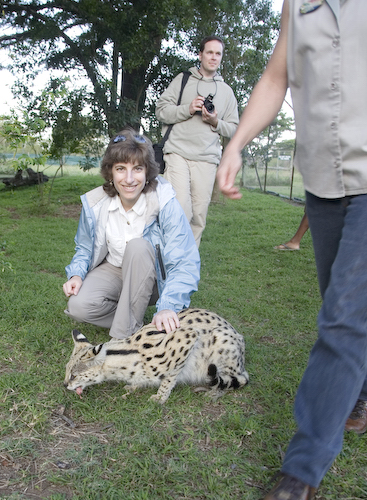
Next up were the caracal. They are a noticeably larger and a lot more wild and aggressive than the servals.
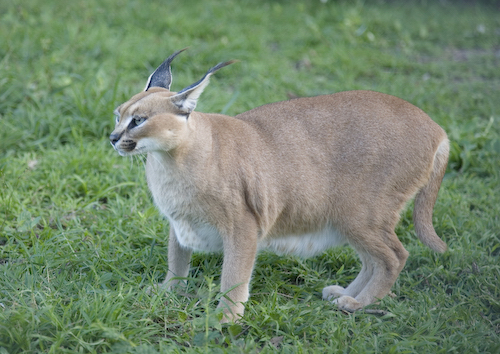
Since the males are so territorial, a second male had to be kept in his own enclosure, and still he managed to fight with the dominant male in the main enclosure. They make hissing sounds not unlike house cats when they're challenging each other or intruders.
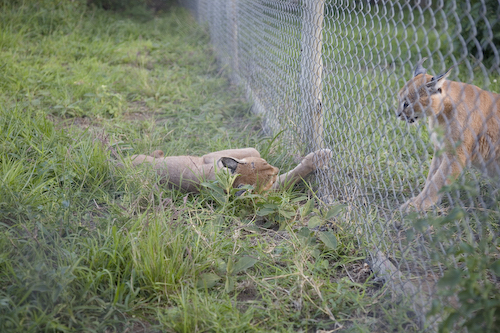
Amanda fed them, but we had to stay outside the pen.
African wild cats are cute little things that look a lot like house cats. In fact, they can and do breed with house cats, which is a threat to the preservation of the species.
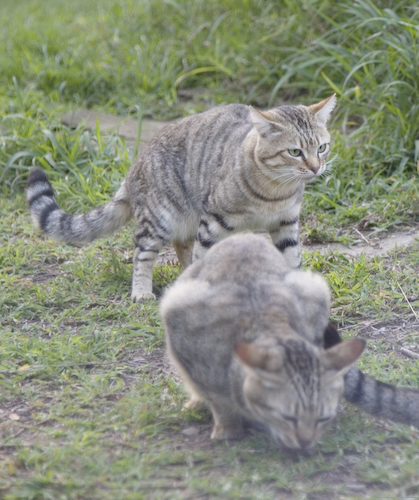
Their distinguishing characteristics are orange ears, green eyes, and rings on their tail and legs. They are better hunters than house cats and run wild in the bush.
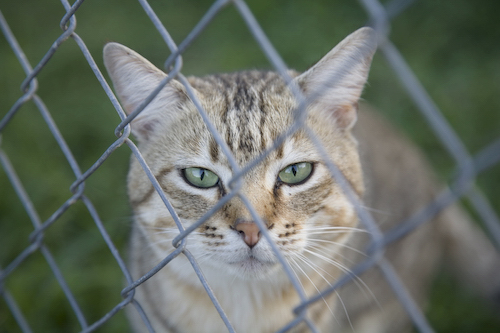
Last up were the cheetahs. Cheetahs face a number of challenges in the wild, even without running into problems with ranchers who hunt them to protect their livestock. Cheetahs are all about speed. Unlike other cats, their claws do not retract. This helps them run faster. Likewise their tails are flat on the side to act as a rudder that helps them make sharper turns at high speeds than the other big cats. In a sprint attack lasting two to seven seconds, they can reach speeds of 45 to 75 miles per hour. Optimizing for speed has costs in strength. Cheetahs must kill by suffocating their prey rather than by the more direct methods of the larger cats. Cheetahs can't defend their prey against lions and leopards and will run away if challenged. (They can't afford to fight, since even if victorious, an injury means no hunting and no food.) To minimize competition with those nocturnal hunters, Cheetahs hunt during the day.
The rehab center currently has three Cheetahs, two females and one male.
Amanda fed the 16-year-old female, Nandi, but didn't let us in. Nandi grew up in the wild and was captured on a farm (thankfully not killed) and brought to the center. So Nandi is a bit too wild for letting tourists into her enclosure. Here she is jumping for a chunk of meat thrown into the enclosure.
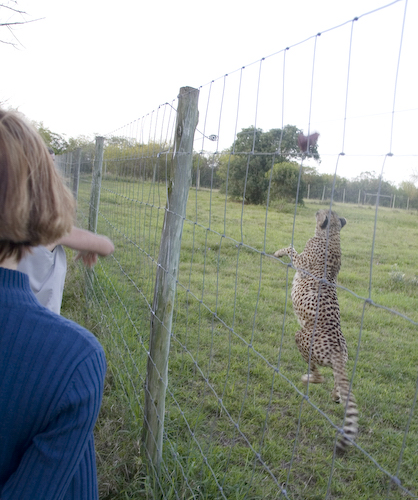
Adjacent to Nandi is Zera, a year-and-half old female. Zera and the two-year-old male Skye spent time together as youngsters, but were separated in hopes that they wouldn't bond as siblings and could later mate. There's a barrier between their enclosures so they can't see each other, and can be reintroduced after they both reach maturity in six months.
With the male, Skye, she did let us into the enclosure, as many of us as were brave enough. She lined us up in a ring around the cat as he ate. He was a bit jumpy and pushed her a little bit, but didn't pay any attention to the rest of us.
One interesting aspect of cheetah anatomy is that they have no collar bone. This means they can't jump very high, because landing would put too much stress on the chest and break bones. We were surprised that the fence around the cheetah enclosures was lower than the enclosures around the smaller cats. In fact, the other cats' enclosures had the straight fence, then at the top, there was a 45-degree segment of barbed wire angling back.
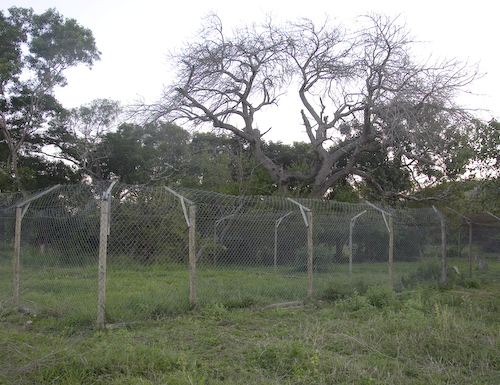
The Cheetah enclosure was lower than the other fences and didn't have the angled barbed wire at the top.
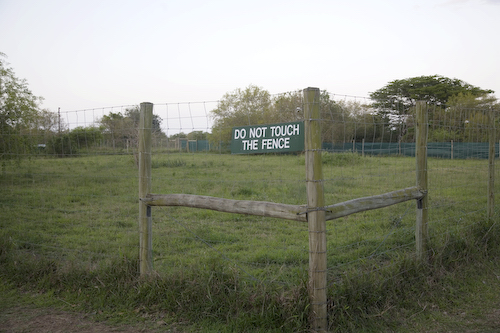
Both Amanda and Marius made a point of telling us how it's impossible for a cheetah to jump a fence that high because they instinctively know the landing would cripple them.
It was kind intense being in the cage with a full grown cheetah, but with a meal in front of him he wasn't that interested in us, especially as a large group. He did of course make sure there was no more meat before moving on.
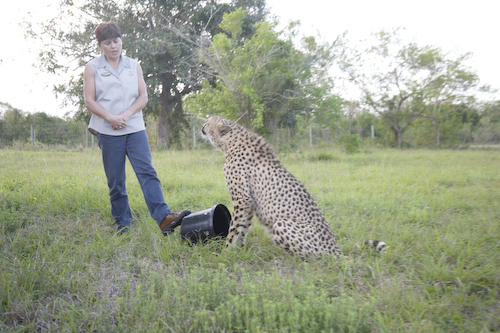
Then he went back to prowling the enclosure after giving us a quick once over.
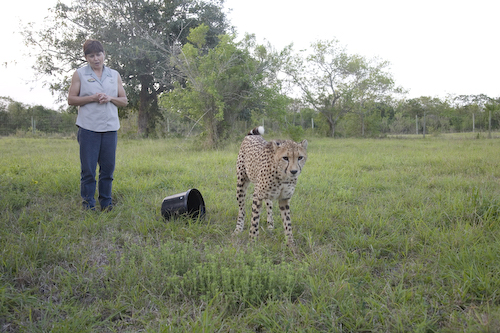
After we were done and the gate was locked, the 25 or so people split up into various conversation groups. We were chatting with Marius and Amanda, while others were revisiting the various cat enclosures. I realized I hadn't taken any photos of Zera, so I started to walk back in that direction.
Here she is in a tree. Even though she is almost level with the fence around her enclosure, she won't jump out because she knows that would injure her. In the background, you can see the green barrier that visually separates her from Skye. Maybe she's trying to get a look at him.
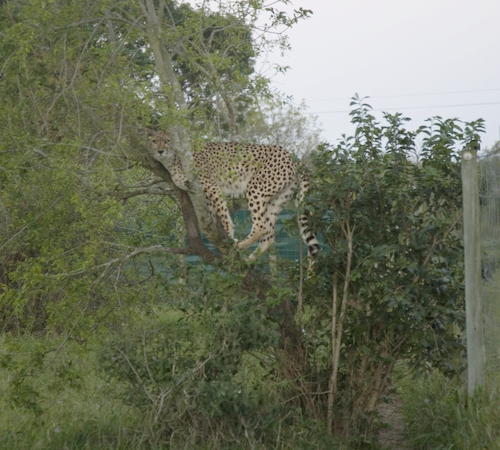
As I got to the fence to take some photos, I noticed there was still a group chatting near the gate to Skye's enclosure and was stunned to suddenly see him jump up onto the top of the fence then down and out of the enclosure within a few feet of the stragglers!
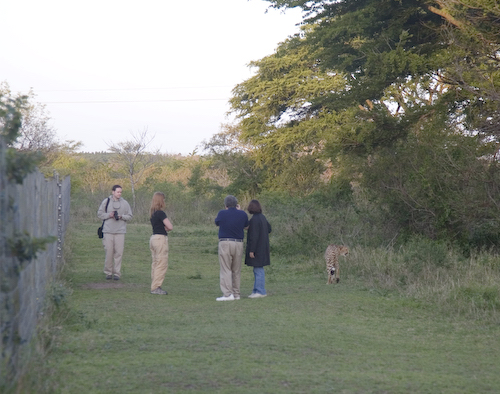
That pretty much demolished the "cheetahs can't jump fences" theory. Amazingly, the tourists kept pretty calm. In fact, in the photo above, you can see Glen taking advantage of the photo opportunity. The group let Amanda know that there was a problem. She and Marius walked over right away to assess the situation.
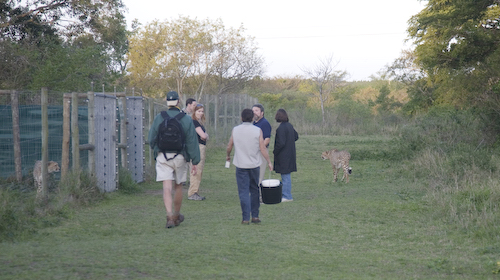
Amanda sent Marius to get help while she tracked the cheetah across the field adjacent to the cage. Marius found the owner, who took some meat out to lure the cat back to the enclosure. After a bit of coaxing, they got him headed back toward the enclosure.
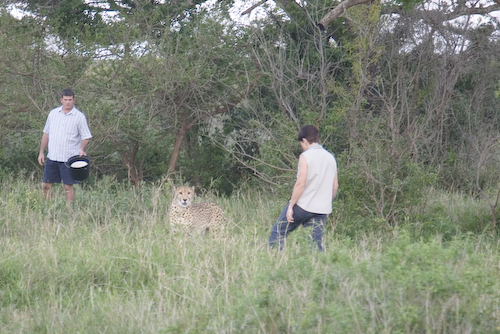
Here's a fun pastime for you: let's play keep the meat from the cheetah.
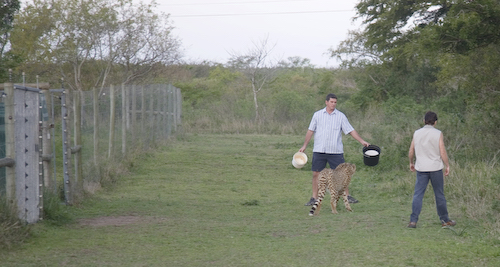
Ah, yes, there's the way back home...
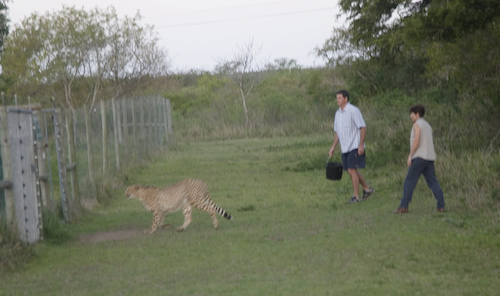
Amanda seems pleased that Skye's back in the enclosure. Since he now knows how to get out of the enclosure, she gets to spend the night baby sitting.
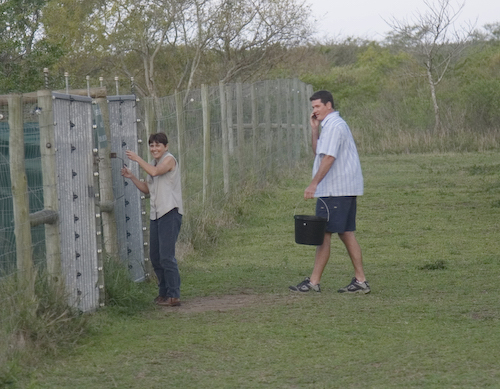
According to the eyewitnesses, it was the sheet used as a visual barrier between Skye and Zera that Skye used to launch himself to the top of the fence. Next up: how to modify the enclosure to make sure they all stay where they belong.
That's three shocking adventures in three days. Africa is a fun place.
All photos ©2006 Tom and Cathy Saxton. All rights reserved.
|
©1996-2025 Tom and Cathy Saxton. You may not copy or reproduce any content from this site without our consent.